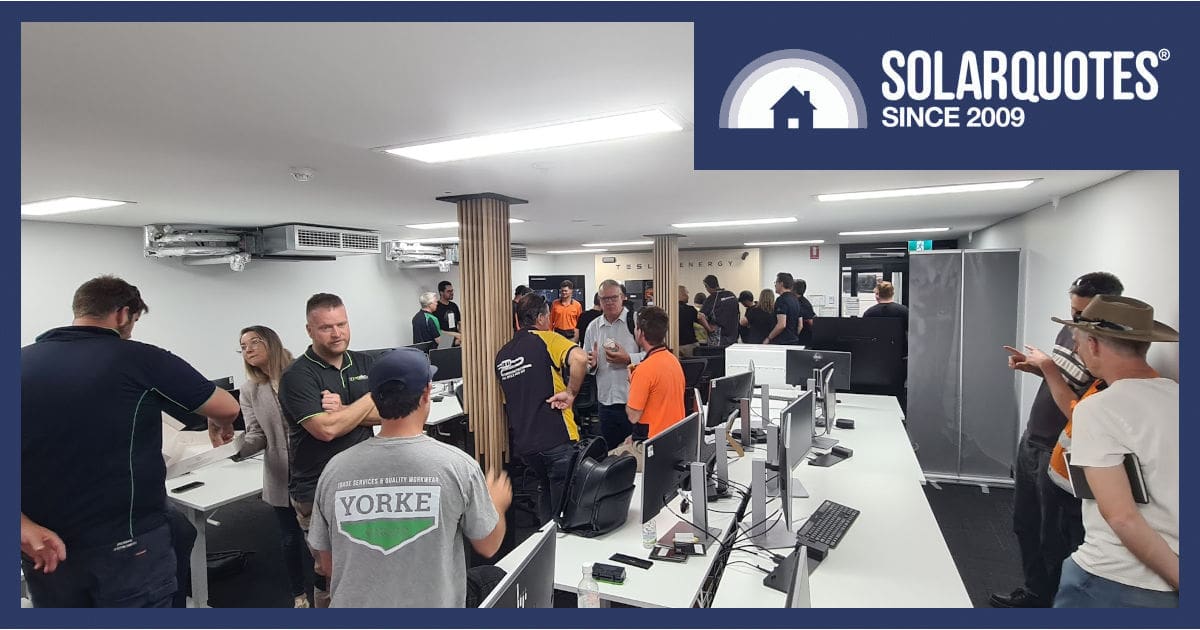
Tesla’s Powerwall 3 is starting to hit the ground in Australia. We’ve had the launch. Selected retailers are humble bragging about their latest Tesla deliveries hitting the ground, and Tesla is running installer training to get everybody ready. I went along on Friday to see what we could glean.
As an SAA-qualified solar electrician, my details can be found, so I get invites, emails, phone calls, spam text messages, and the odd veiled threat from all kinds of places.
The most entertaining are the cheap sales companies looking for subcontract installers or sales lead companies looking to sell me customer details. They’re so busy reading a script that they never cotton on when I quote them my email address. I’ll write some whole articles about it one day, but for today’s anecdote, I have to explain that I get a unique perspective inside the solar industry.
As a fiercely independent 3rd party SolarQuotes sometimes has to fend off brand marketing executives who are looking for payola or cash for comment. The better class of manufacturer, like the ones on our recommended chart, realise that if they make better products, they’ll get a fair writeup. And if there are new models to be had, or some training to be done, then we’re keen to hear about it, because it means we can inform you, the buying customer, what’s coming next.
Same Same But Different
All inverters and batteries are built to perform the same essential functions, but each model comes with its own standout feature or drawback. For some buyers, these can be deal makers or deal breakers. Take the Fronius Gen 24, for example: it offers a unique PV point for backup without a battery, something no other model does. Yet, it lacks seamless battery changeover during power outages. Personally, I don’t see its analogue outage signal as a flaw, but for others, it might be a deciding factor.
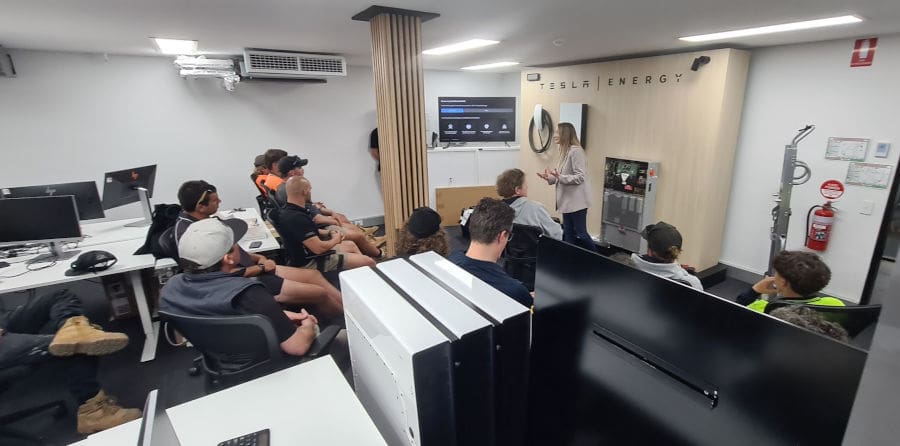
Now pay attention, class… it was a standing room only for half of us.
No Disturbing Surprises
I’m happy to report training didn’t produce any sharp inhalation or low whistles from the two dozen assembled tradesmen. Everything was well received, with only one question unanswered, subject to confirmation.1
Tesla’s Powerwall 3 is arguably not the best device for a 3-phase property, but the company is acutely aware of this and expressed some optimism that one day, it will have a solution for 120º synchronous loads.
Seeing as Tesla introduced a specific North American EV charging standard that ignores the rest of the world and precludes three-phase charging, I expect Powerwall will support three phases as soon as hell freezes over or the Americans admit 110 volts is for peasants.
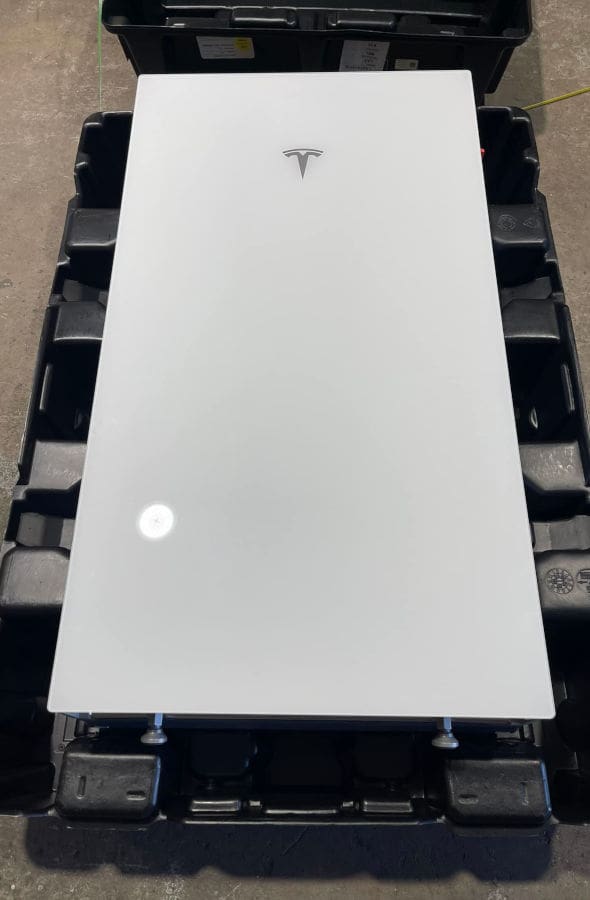
The feet at the bottom must stay in place, even if the unit is wall-mounted, to ensure nothing obstructs the air intake for cooling the PW3. image credit Skyline Solar
Here are some notes customers might be interested in:
PW3 comes in 5, 10 and 11.04kW nominal AC capacity
- The inverter capacity is “set in stone” during commissioning
- Only Tesla can reset it, and they’ll want written proof of DNSP permission.
PW3 has embedded heating elements in the battery.
- In snowy conditions the battery can be preheated at dawn, ready for charging, just like EV batteries.
PW3 has a slick glass front panel, and we all know how that’s going to go sometimes…
- Replacement panels are around $150.
PW3 comes packed inside a reusable clamshell pallet.
- The packaging has a refundable deposit.
- They can stack 9 high in the warehouse.
Last time I saw a good attempt made at a circular economy in solar was with another US company. Evergreen “string ribbon” panels came on a decent timber pallet with building grade 10mm plywood top, both of which made good shelving and dog kennels. The unique part was each panel had a sturdy plastic corner to make them stack nicely, and these corners could be thrown in the flatpack prepaid cardboard box and freighted back to the factory… if you were in the US.
Silex Solar offered a deposit on pallets they sent out of Sydney, too, but sadly, they didn’t last long either.
For installers, there are a few more points:
Parallel arrays need to be connected upstream.
- There’s no way to connect parallel cables inside the inverter.
- The DC isolator assembly is supplied with specific terminals
- Tesla is yet to clarify if these accept 4mm² or 6mm² cable
I wouldn’t like to see installers using branch connectors on the roof, but using “WAGO” connectors inside the inverter might be possible.
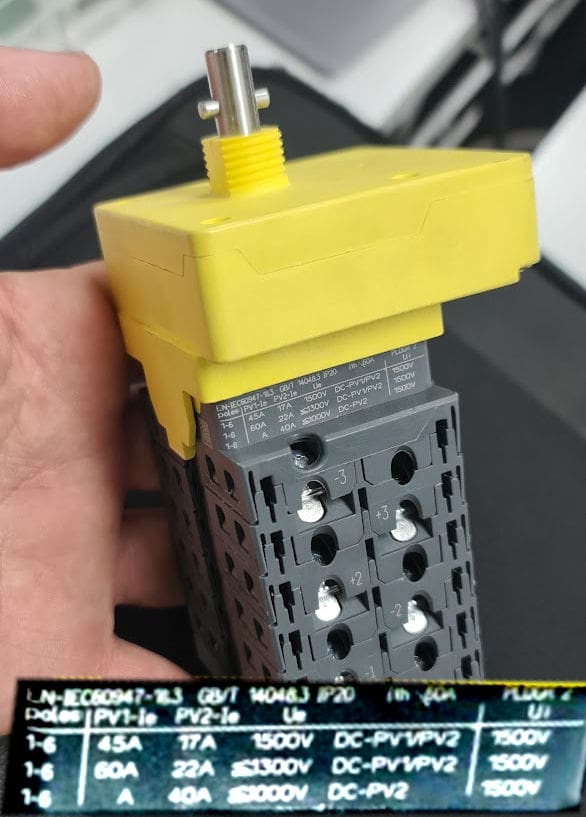
The DC isolator mechanism simply will not accept more than one cable per terminal. The connections are angled and need to be filled from one end to the other. Tesla supplies a screwdriver bit for this purpose.
Tesla has really put some thought into manual handling, which is essential because this thing is 130kg!
- Opening the clamshell, you attach some handles that come with the special Tesla wheeled dolly.
- Using the dolly, you stand the unit up and wheel it to the wall bracket you already installed.
- Using your cordless drill, lift the unit onto the wall.
- I haven’t used this package myself but it really does look well executed.
- For $3000, it needs to be a very good dolly.
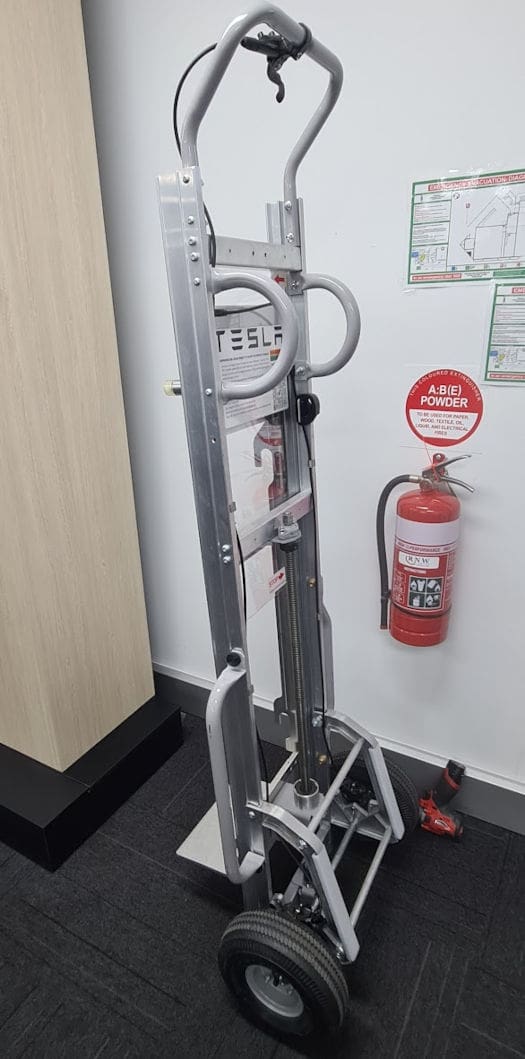
My 5-year-old said she didn’t think this was a good dolly and wasn’t about to cuddle it.
CAN communications to Gateway.
- Powerwall 3 uses the same Backup Gateway 2 used by PW2
- The brain of the operation is now the TACO inside PW3
- (Tesla Asset COntroller)
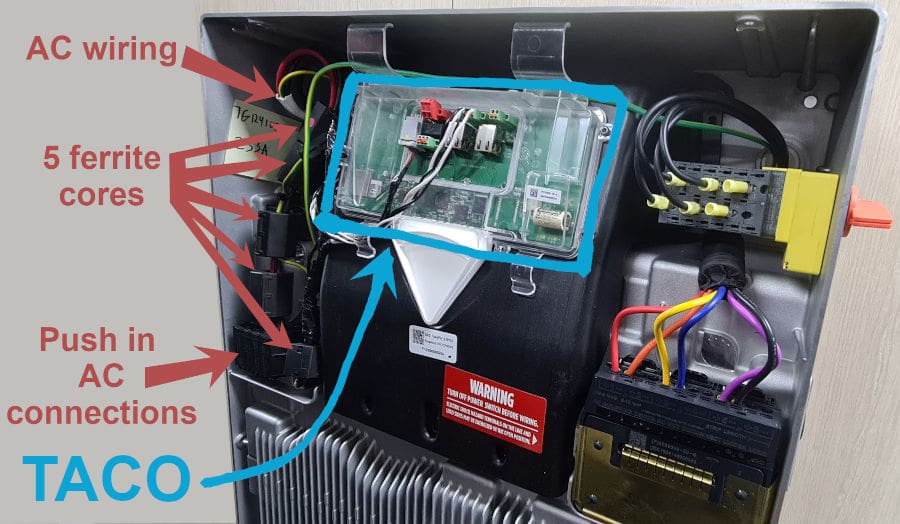
TACO accepts extra low voltage signals, CT coil wiring and gateway comms & internet
Knockouts are not to be drilled out.
- Holesaws create metal filings and must not be used
- There are several cable access holes on the side and rear of PW3
- AC connections are on the left, DC on the right
- Space inside the unit will accommodate conduit for segregation, but pressure against the inside of the glass must be avoided.
- Solar array earth could pass through the unit to the AC connections; however
- Disconnecting the array earth to replace the inverter isn’t considered acceptable, so the 4mm² array earthing cable really needs to be routed back to the main switchboard separately.
There are no less than 5 ferrite cores supplied inside the unit
- AC wiring needs to be threaded through these cores to filter electrical noise.
- (because Australians don’t use metal conduit, knife switches or other 1920s technology)
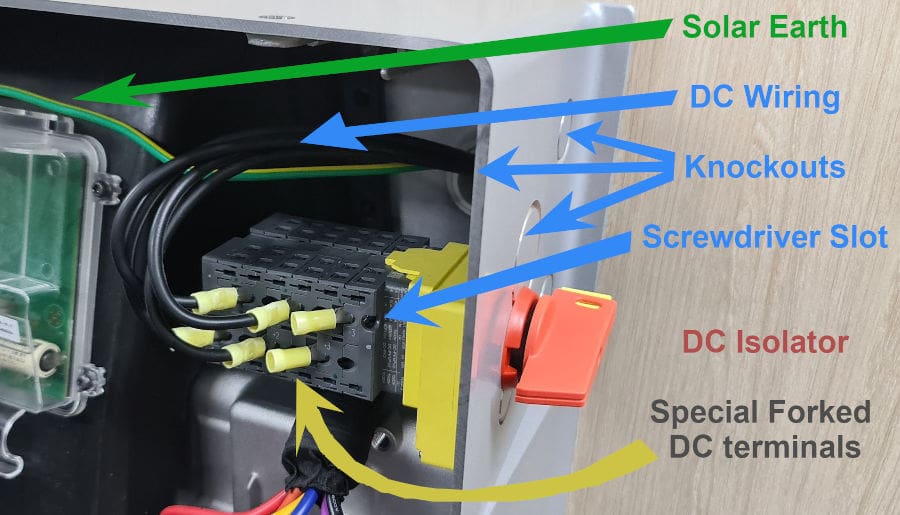
This PW3 is an engineering prototype so the knockouts shown here are US specification, not indicative of Australian units.
Powerwall 3 supports 5G WiFi
- Greater compatibility with domestic internet connections
- There’s an onboard cellular modem for fallback communications.
- AC supply will enable settings, so panel installation need not be finished before commissioning & troubleshooting can begin.
Powerwall 3 will support flexible exports.
- You can have multiple units on one site, they’ll all be compatible with dynamic DNSP control.
- PW3 doesn’t talk to PW2
AC-coupled solar will need a Current Transformer (CT) coil.
- If you have legacy solar on-site, there must be a measuring coil hardwired into the PW3
The Two Disappointments
PW3 does not support the Neurio wireless devices used for PW2.
This means if you have legacy solar on a separate switchboard or a different building, it can’t be easily measured. They say wireless metering for the PW3 is coming next year, but until then, the lack of Neurio could be a real stumbling block on some installations.
As of mid November we’ve also come to learn that PW3 isn’t compatible with Tigo optimisers, so they’re off the cards.
Roll On The Installations
CEC approval is the only impediment now, so while it would be risky to hold your breath, I’m sure we’ll see Powerwall 3 out in the wild sometime soon.
I’m keen to see how these units come together, and I’m sure, given the exceptional levels of consumer interest we have been seeing, so is the solar-buying public.
Footnotes
- I have it straight from the horse’s mouth, Tesla engineering confirms the throttled-down 5kW PW3 can still have 20kW of solar PV attached ↩

 RSS - Posts
RSS - Posts



Great stuff Anthony. Totally agree with your skepticism about a 3 phase PW3 ever materialising.
Did they confirm, once and for all, categorically, no take-backsies, no crossed fingers, legs or anything, that those battery cells inside are Lithium Iron Phosphate or not ?
Very interested that they said…
“The inverter capacity is “set in stone” during commissioning”
I’m sure our DNSP, Western Power will be reassured by that with pesky customers and installers blocked from upping their 5kW to a sneaky 10kW inverter, BUT…is there also something to stop the installer not crippling it in the first place? I can just imagine naughty customers whispering in the installer’s ear…make it a 10, make it a 10… or even an 11.5.
New Powerwall 3 here, still not able to connect to its wifi hotspot, it refuses despite power cycling and going though all the steps or even a manual connection. Hopeless, as is no response or support from Tesla.
Just give me a 50kWh battery packaged up with a decent output and stop messing around with all these small and modular battery units. The wholesale cost of 50kWh is only $9.5K. Why isn’t anyone producing a decently large size house battery so that no-one will have to worry about upgrading for a very long time and it will run your house for days? Should be a profitable exercise to sell it for between $20k to $25k with all the additional bits added on. What’s holding this back, except greedy battery companies that know they can blatantly rip people off atm?!?
The biggest issue is finding a CEC approved grid tied inverter and accredited and willing installer to handle those big cheap 48V Chinese mail order packs. Those who absolutely know what they are doing and can mostly DIY can save a mountain of money. For the other 99.999% the learning curve, risks and skillset are usually insurmountable.
That’s still my question though Drew – why isn’t there anyone doing it? Surely there’s a good profit to be made on each battery. If GWM can release their Ora LR with a 63KW battery for $35,000 last week, why can’t a solar company put the same size battery in my house for that price of say $25-30K? A car is a hell of a lot more difficult to put together than an inverter and the associated software etc. I just don’t get it.
I wish Solar Quotes would actually look into this and write a proper article about it, what would be involved, what a good price would be, who might actually be in a position to do something about it? It would make such a huge difference right from the home owner, through to climate change implications for all of Australia, if we could store a decent amount of energy and use that to run our houses and stabilise the grid.
Hi Anthony,
Is there anything concrete about how/when/if it will be determined that a PW3 needs to be throttled (to 10 or 5 kw)?
I understand the comments about the PW3 not being the best option for a 3 phase home, but at the same time, having a 3 phase home, and being happy with a single phase backup still (3 phase devices not critical) still seems like a good option on paper, unless 100% of these setups would be throttled to 5kw…
Hi Callum,
The 5kW throttle means you have the same charging & discharging capacity as the PW2, which isn’t to be sneezed at. It’s not a dynamic change though, once set at 5kW the PW# is locked in at that level, it won’t support more load.
The main reason you’ll have to have a 5kW unit on a 3 phase connection is that there can’t be more than 5kW of imbalance between phases.
ie If you had three solar inverters, one on each phase, it could be a combination of 3kW, 5kW & 8kw… That’s OK because there’s not more than 5kW difference between the 3 and the 8
If you want a full capacity 10kW PW3, you’ll need another two inverters, one on each of the other two phases, to balance the supply. They could be 5, 8 or even 10kW perhaps?
Why is it that you can’t have an imbalance of more than 5kW between phases at your property? Is this an issue for the household level? Surely at a larger scale the imbalance on one phase isn’t likely to be an issue?
Hi Phil,
Rules is rules. The DNSPs like phases to be balanced so they don’t have as much current imposed on the neutral cable back to the street transformer.
There’s 17 different DNSPs and some have different rules or will allow exemptions.
Hi Anthony, can the PW3 charge the batteries/power the house when the grid is “down” directly off solar for extended blackout/disaster support.
yes
Yes Dale,
They’ll run on DC solar but like the PW2 aren’t warranted for extended off grid use.
Hi,
I’m building a new house with 3 phase power, 13kw solar and an EV charger. I’m not that bothered about backup power.
I have quotes for a Sungrow 3 phase Inverter and SBR 9.6kWh battery. I’m wondering whether a Powerwall 3 with built in inverter might be a competitive alternative?
Thanks,
Craig
Hi Craig,
We always recommend a 3ph inverter for a 3 phase supply, but there are workarounds if you must have a shiny white Tesla.
There’s a few more explainers here :
https://www.solarquotes.com.au/search/?addsearch=3%20phase%20battery
You might also look at a Sigenergy system, as of today they’re now approved for 3 phase.
Your https://www.solarquotes.com.au/blog/3-phase-battery-trap/ article suggests that a three phase battery backup isn’t all that necessary? An integrated battery and inverter seems like a good idea and if backup is not of particular concern (more than the one phase at least) then PW3 should be a good option?
Hi Phil,
We have a couple PW3 blog posts going over the issues but as an example :
10kW single phase will deliver 40a in backup.
10kW three phase will deliver 14.5a in backup, because it’s split 3 ways.
So 3ph units aren’t as capable at starting motors in a fridge or rainwater pump.
However the PW3 can be hamstrung by 5kW phase balancing rules imposed by the network, so they’ll deliver about 22a in backup.
Hi Anthony,
I am in the process of installing a 13kw solar system with Tesla PW3 on 3 phase home.
Having read the post about the PW3 workaround options, I am not much concerned about the backup on one phase only.
However, the company delivering the solution advised that “the use of Tigos on Powerwall 3 systems can create unreliable interruptions to the Powerwall inverter”, but they do want to proceed with the installation.
Obviously I am concerned about the reliability of the system and Tesla not providing support for a system that is not recommended by Tesla.
From what I understand my other alternative is enphase microinverters which I am discussing with the supplier.
Is there any point considering Tigos at all?
Are there other alternatives to consider?
Toma
Hi Toma,
TIGOS are not compatible with Tesla PW3, I have that direct from Tesla’s head of engineering in Australia.
Unless you have a really complex roof I wouldn’t think Enphase is worth considering but it’s hard to tell without a plan sorry.
iStore have a good flexible optimiser solution but I wouldn’t consider APS, Hoymiles or any others.
For a 3 phase home I really recommend a 3 phase solution like Fronius Gen24, especially when you consider an EV charger, or Sungrow SH15.
I spoke with Tigo Australia about Tigos on PW3 and they say they work fine with plenty of Australian installs with PW3 done already.
The Tigo rep said that in the USA they might interfere with PW3’s AFCI, (arc fault detection) but that isn’t available, according to Tigo, in the Australian PW3 version.
He said that as with any other inverter, Tigos shouldn’t be used selectively on any panels that are part of parallel strings. As PW3 Australian architecture is 3 MPPTs all of which can take two equal length parallel strings maybe that’s why Tesla are saying no. Can’t see how it could cause a problem if the optimised string wasn’t in parallel though. Another solution would be to put Tigos on ALL the panels.
However, if Tesla are saying a flat ‘no’ to Tigos then that raises warranty issues giving them an out on any claim where Tigos are fitted.
Would love to read the reason the head of Tesla engineering said no.
One thing potential PW3 purchasers have to think about is the battery callibration. My battery has gone through 3 “callibration in process” in 6 weeks.
This basically takes it off line for 12 hours while it runs down to zero % from 100%. Despite what they say in the documentation the PW is not usable for backup at any time since it takes the charge down to zero.
Frankly, if I knew this I would have gone with another system. My house uses huge amounts of power and taking it off line costs me a lot. It was not mentioned at all in their sales blurb.
Right now I wouldn’t recommend the product.